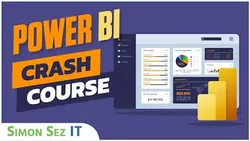
Microsoft Power BI for Beginners - 2 Hour Power BI Crash Course! 
This two-hour crash course introduces beginners to Microsoft Power BI Desktop. It covers topics such as what Power BI is, how to acquire it, and how to import CSV, Excel, and text files. Additionally, participants learn how to create lookup tables and merge queries. By the end of the course, participants will have a better understanding of Power BI and its capabilities. ▼
ADVERTISEMENT
Course Feature
![]() Cost:
Cost:
Free
![]() Provider:
Provider:
Youtube
![]() Certificate:
Certificate:
Paid Certification
![]() Language:
Language:
English
![]() Start Date:
Start Date:
On-Demand
Course Overview
❗The content presented here is sourced directly from Youtube platform. For comprehensive course details, including enrollment information, simply click on the 'Go to class' link on our website.
Updated in [February 21st, 2023]
This two-hour crash course provides an introduction to Microsoft Power BI for beginners. Participants will learn how to work with templates, share and collaborate with others. The course will cover the basics of Power BI, including how to create visualizations, use filters, and create dashboards. Participants will also learn how to share their work with others and collaborate on projects. By the end of the course, participants will have a better understanding of how to use Power BI to create meaningful visualizations and reports.
[Applications]
This course provides a comprehensive introduction to Microsoft Power BI for beginners. After completing this course, users will have a better understanding of how to use Power BI to create visualizations, work with templates, and share and collaborate with others. Suggestions for applying this course include:
1. Utilizing Power BI to create visualizations of data to gain insights and make informed decisions.
2. Exploring the various templates available in Power BI to quickly create visuals.
3. Sharing and collaborating with others using Power BI's collaboration features.
4. Creating dashboards to monitor and track data in real-time.
5. Integrating Power BI with other applications and services to create powerful data visualizations.
[Career Paths]
1. Business Intelligence Analyst: Business Intelligence Analysts are responsible for collecting, analyzing, and interpreting data to help organizations make better decisions. They use a variety of tools, such as Power BI, to create visualizations and reports that help organizations understand their data. As the demand for data-driven decision-making increases, the need for Business Intelligence Analysts is expected to grow.
2. Data Scientist: Data Scientists use a variety of tools, such as Power BI, to analyze large datasets and uncover insights. They use their findings to develop predictive models and create data-driven solutions for organizations. As the demand for data-driven solutions increases, the need for Data Scientists is expected to grow.
3. Data Visualization Designer: Data Visualization Designers use Power BI to create visualizations that help organizations understand their data. They use their design skills to create visually appealing and informative visualizations that help organizations make better decisions. As the demand for data-driven decision-making increases, the need for Data Visualization Designers is expected to grow.
4. Business Analyst: Business Analysts use Power BI to analyze data and uncover insights that help organizations make better decisions. They use their analytical skills to develop strategies and solutions that help organizations reach their goals. As the demand for data-driven solutions increases, the need for Business Analysts is expected to grow.
[Education Paths]
1. Bachelor of Science in Business Analytics: This degree path focuses on the application of data analysis and predictive modeling to solve business problems. It covers topics such as data mining, machine learning, and data visualization. Students learn to use tools such as Microsoft Power BI to analyze data and create meaningful insights. This degree is becoming increasingly popular as businesses become more data-driven and need professionals with the skills to make sense of the data.
2. Master of Science in Data Science: This degree path focuses on the development of data-driven solutions to solve complex problems. It covers topics such as data mining, machine learning, and data visualization. Students learn to use tools such as Microsoft Power BI to analyze data and create meaningful insights. This degree is becoming increasingly popular as businesses become more data-driven and need professionals with the skills to make sense of the data.
3. Master of Science in Business Intelligence: This degree path focuses on the application of data analysis and predictive modeling to solve business problems. It covers topics such as data mining, machine learning, and data visualization. Students learn to use tools such as Microsoft Power BI to analyze data and create meaningful insights. This degree is becoming increasingly popular as businesses become more data-driven and need professionals with the skills to make sense of the data.
4. Master of Science in Artificial Intelligence: This degree path focuses on the development of artificial intelligence (AI) systems to solve complex problems. It covers topics such as machine learning, natural language processing, and data visualization. Students learn to use tools such as Microsoft Power BI to analyze data and create meaningful insights. This degree is becoming increasingly popular as businesses become more data-driven and need professionals with the skills to make sense of the data.
Course Provider

Provider Youtube's Stats at AZClass
Discussion and Reviews
0.0 (Based on 0 reviews)
Explore Similar Online Courses

VS Code - Next level COBOL & RPGLE dev with VS Code

MySQL Full Course ️ (2023)

Python for Informatics: Exploring Information

Social Network Analysis

Introduction to Systematic Review and Meta-Analysis

The Analytics Edge

DCO042 - Python For Informatics

Causal Diagrams: Draw Your Assumptions Before Your Conclusions

Whole genome sequencing of bacterial genomes - tools and applications

Microsoft Power Platform
![Microsoft Power BI : A-Z of Power BI in 90 Minutes : 2023 [Updated]](/ccsimg/td_book/check/c3335b84f65d0fc9166ae7cb130df533.webp)
Microsoft Power BI : A-Z of Power BI in 90 Minutes : 2023 [Updated]


Start your review of Microsoft Power BI for Beginners - 2 Hour Power BI Crash Course!